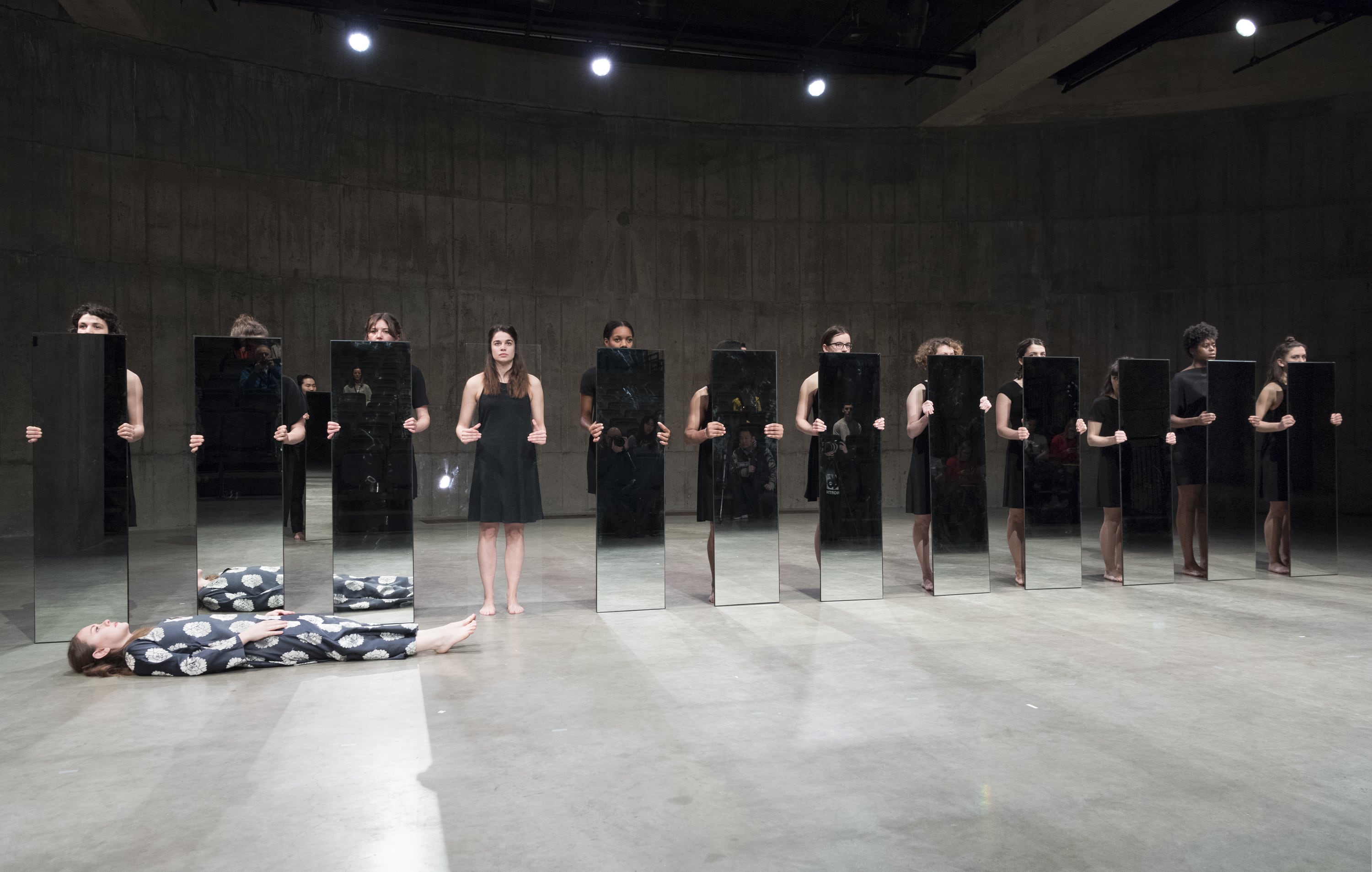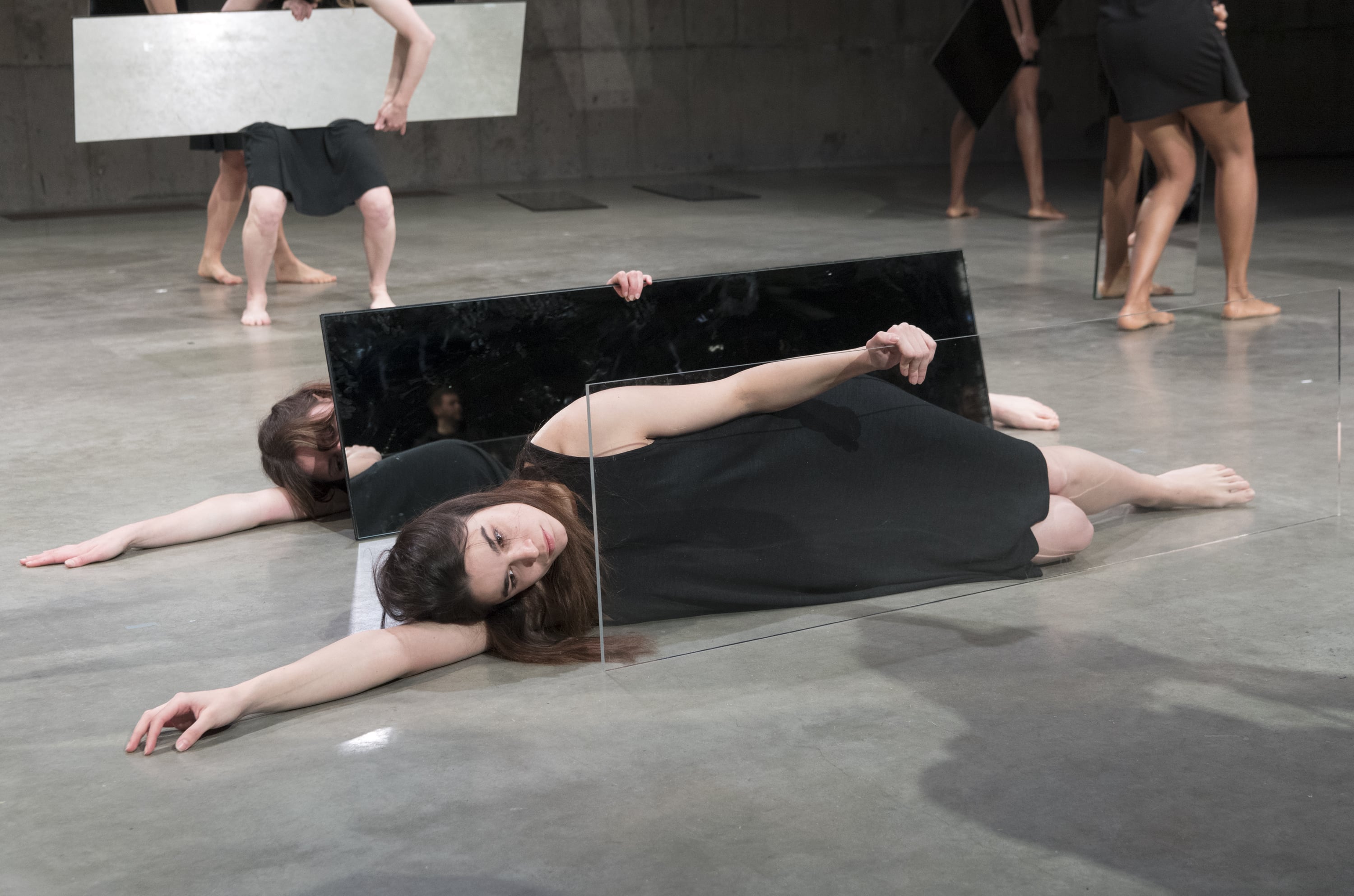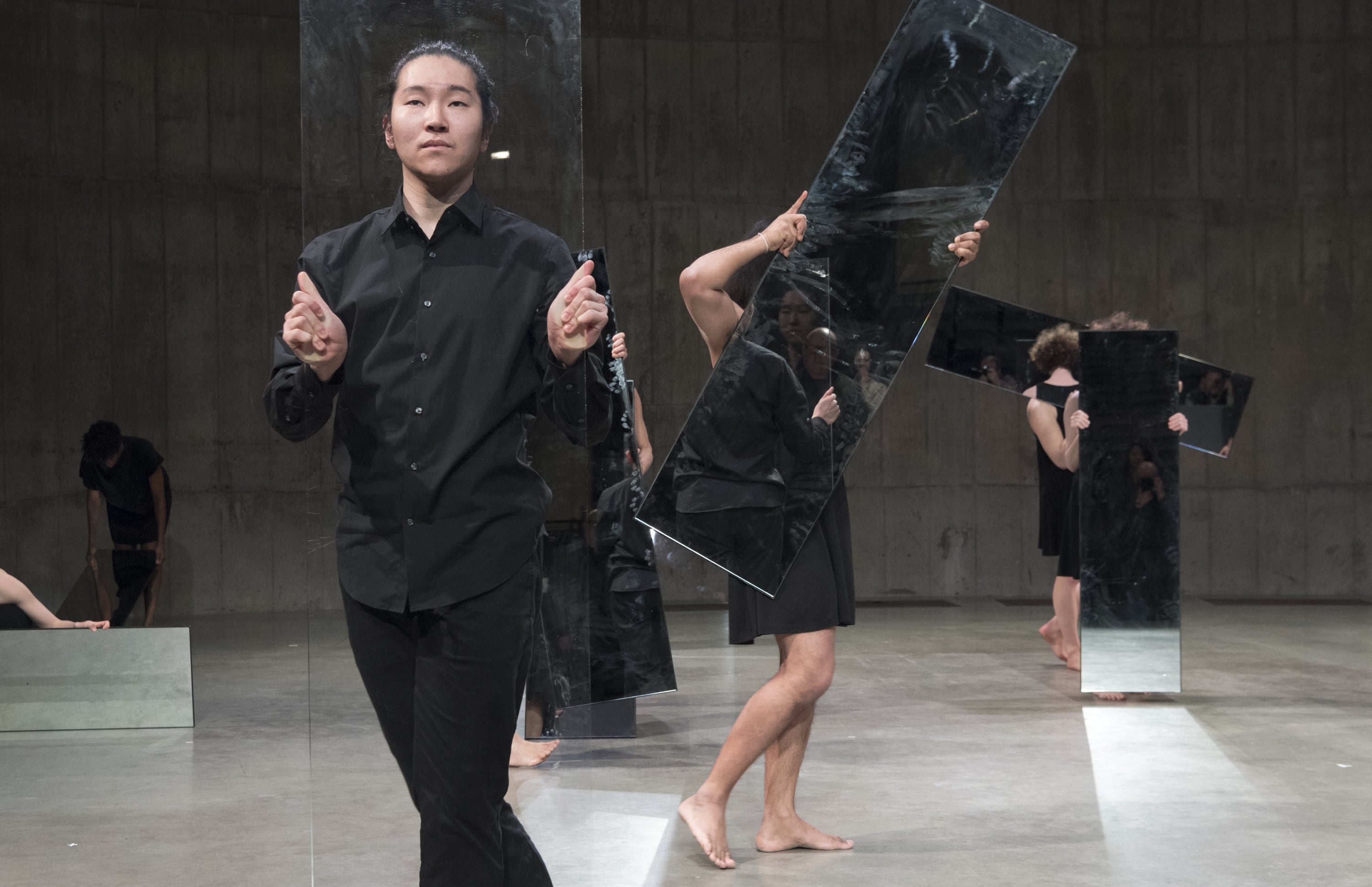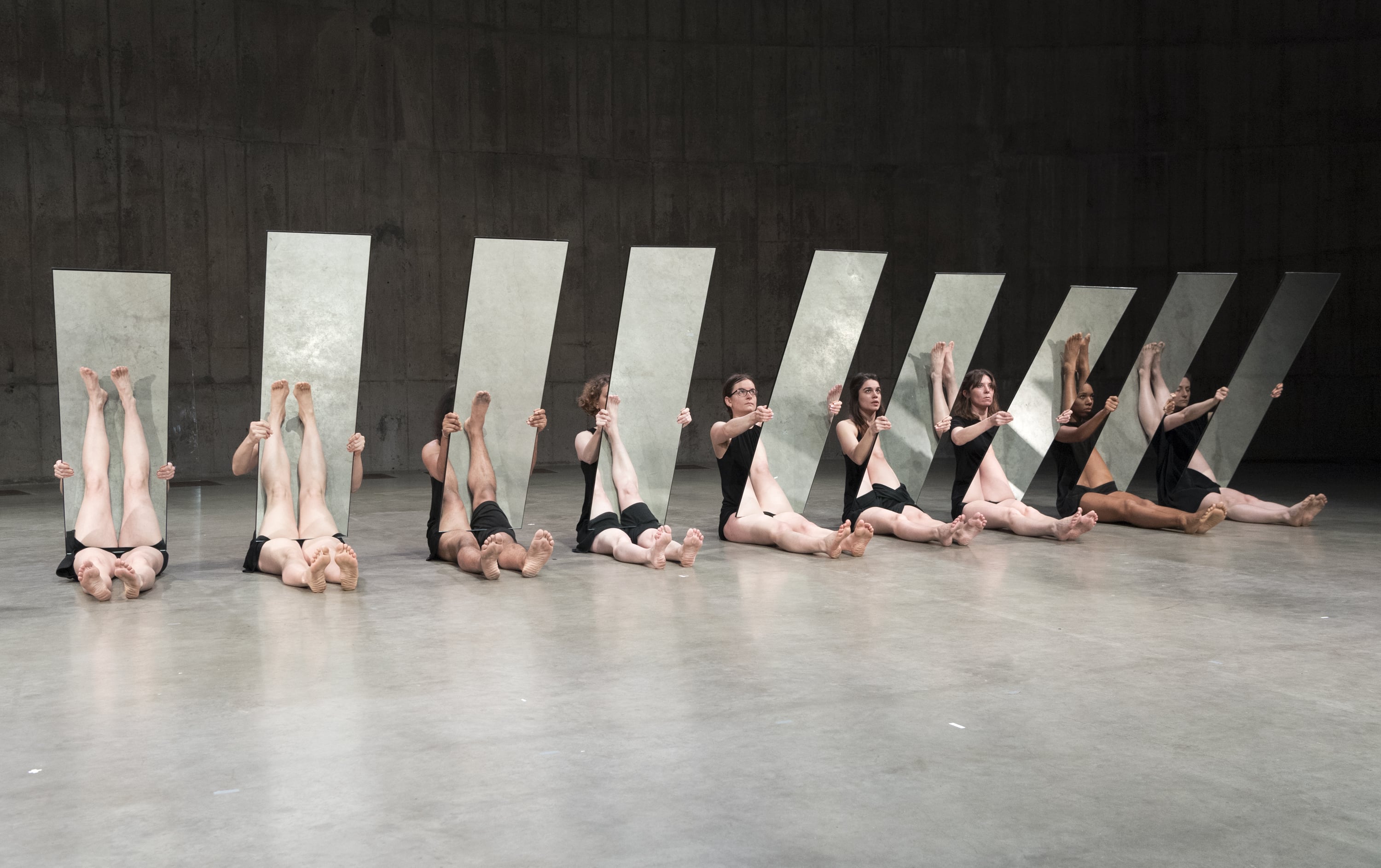



Artists: Joan Jonas, Jason Moran, Sylvia Palacios Whitman, Mark Leckey, patten.
Curators: Catherine Wood, Isabella Maidment, Andrea Lissoni
There is a particular gravitas, a level of respect, that an artist can earn by sheer tenacity and longevity. And judging by the scope and breadth of her career survey at Tate Modern in London, Joan Jonas has earned that respect. As well as the main exhibition, which runs until August, there are a selection of installations in the Tanks, at the base of the new-ish Blavatnik extension, serving as a kind of counterpart to the BMW Tate Live series of performances.
For Ten Days: Six Nights, the aforementioned performances, Joan Jonas has revisited three of her early works from a career spanning fifty years, sketching out the period during which she went from being a sculptor to a predominantly performance artist. The evening was divided into two parts. In the first, Mirage, Jonas would be performing alongside herself from forty years ago, blending live interactions with film and video works made during that period. In the second, various artists would perform in solo and group compositions, recreating older Jonas’ works.
At the outset of the performances, Jonas gave a short speech outlining the evening’s procedures and the rationale behind some of the staging decisions. She detailed how the stage arrangement and set-up was altered to suit the large space in the Tanks, remarking that she was used to presenting in more intimate spaces. For this reason, too, the film/videos were projected behind the performing Jonas, as well as shown on a CRT monitor which had been placed on its side stage left. The monitor (monochrome) had a purplish tinge from its own ageing and metamorphosis; an appropriate metaphor. Jonas has created videos by placing the camera side-on from the outset, pre-empting the smartphone ‘portrait’ format, and inadvertently putting herself about forty years ahead of the game. The sets themselves, and the objects and sequences within the sets, were treated as props rather than sculptures, and as such were manipulated as required. Among these were some distinctive horns, a recurring motif in Jonas’ work;paper cones and later made from tin, including one three metres long, which her assistant held for her while she spoke and sometimes blew into it at both ends.
This performance of Mirage (first performed in 1976), was the first by the artist herself since 1980. One of its component works was )Good Night Good Morning,_ in which Jonas addresses the video camera directly over a period of weeks. Simple in concept, it was deeply affecting in its portrayal of the artist’s changing moods over the days and weeks that it was recorded. Alongside Good Night Good Morning, there are sequences of video works from this earlier period that Jonas incorporates into her performance, and which feature spoken word readings and symbols - curved lines which the younger Jonas chalked onto a blackboard.
There was something of the tragi-comic about this iteration of the performance; dressed in a white satin pyjama-style outfit, Jonas sits on an undersized white chair, attempting to keep up with her younger self, all the while chalking designs on an old-fashioned school slate. But there was also obvious self-awareness. The comedy and pathos were calculated. Jonas’ forty-minute tour concluded with an intense routine featuring the (now eighty-two year old) artist running on the spot, towards a back-projected volcano (another well-known Jonas motif) for a full five minutes.
The second half begins with Mirror Check; a naked performer meticulously examines herself with a small hand-held mirror. She scrutinises all parts of her body, including those one cannot normally see oneself. This is a recreation of a piece first performed in 1970,one of Jonas’ defining works and one in which she set out to explore questions of identity and body image, its fragmentation and depersonalization.
Following this is Mirror Piece II, a relatively complex work with performers speaking in tongues while arranged in a closed circle. The dancers, female and male and gender fluid, were dressed in short black mini-dress-like shifts, perhaps a nod to, or acknowledgment of,shifting attitudes towards gender. Indeed identity, and its malleability, has been an important central theme of Jonas’ work. Her collection of masks, on view as one enters the main exhibition at Tate Modern, grew from her fascination first with Butoh theatre and then with the possibilities of shifting identities as an artist. This fascination with identity is also reflected in Jonas’ ongoing use of the mirror as an object to reflect and structure and fragment perspectives. The performers in Mirror Piece II all enter the space holding mirrors, except for one who holds a sheet of clear glass. Turning the mirrors towards the audience, suddenly the work is looking at, or scrutinising, the viewer. The audience look back at themselves, look for themselves in the reflection, wondering whether the performers or other members are looking at them, and so begin a multitude of inner dialogues during the moments they are being reflected ...
Jonas is one of those figures whose influence always seems to have been there, not least because it has been refracted through the practices of other, younger artists. Having the opportunity to experience her performance first-hand,it becomes striking just how pervasive this influence has been. Self-examination, reflection, dialogue, between performer and audience but also inner dialogue, made jarring over time - all these things are at the heart of this selection of performances. And after such a length of time and with such a body of work there doesn’t need to be anything explicatory in order to generate a sense of the profound. To engage with your forty-years-younger self, and to do so with vigour and entirely in the moment, is something not many artists are lucky enough to achieve.
Matthew Crookes is a writer and artist. In 2014 he graduated from Elam School of Fine Arts, University of Auckland with a Doctor of Fine Arts degree. He maintains professional links in Germany and Britain, among other places.
